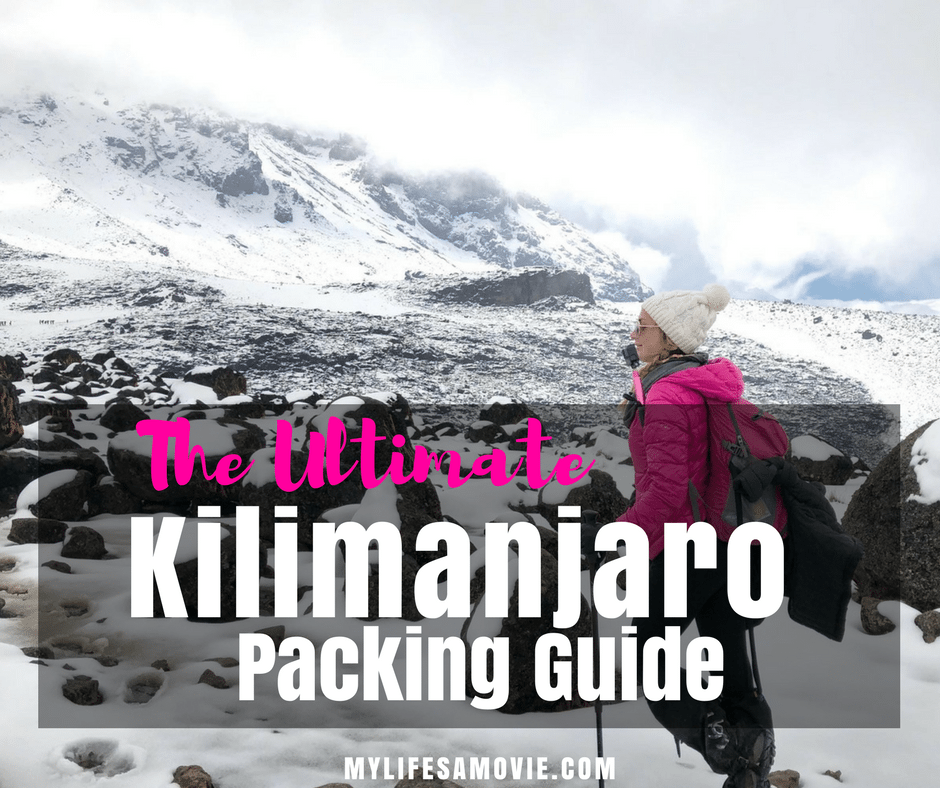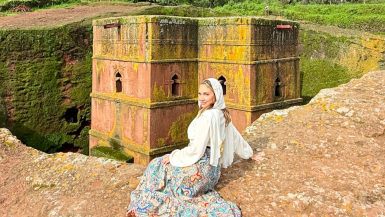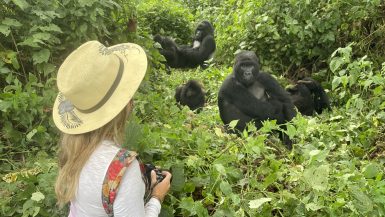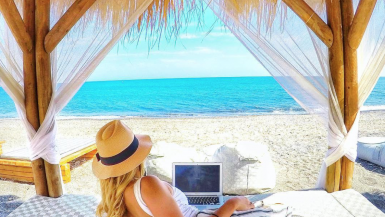I’m not going to lie, I had a very rough idea of what to pack for Kilimanjaro, and it was initially probably only half of this Kilimanjaro packing guide by Whoa Travel!

There was probably also a point where I thought I could just get by with what I had, but luckily I asked “how important is it to have _____” before I left, because Whoa’s answer was, “Everything on the packing list is mandatory.”!
It may seem overwhelming at first but I promise it’s not as much as it seems. It’s definitely important to not pack MORE than they recommend because you literally only get a certain amount of weight to have in your duffel…and you want your day pack (which you carry the whole time) as light as possible. Otherwise you’re going to have some serious trap muscles!
Anyway! Everything in black print below is from Whoa Travel’s official packing list, and anything in pink is my two cents on the actual items I had plus some tips. I’m also inserting the links to the actual items I bought, used, and would recommend in case you’re looking for some ideas!
You can also print out Whoa’s packing list here: Kilimanjaro Packing Checklist
Sidenote: I use Amazon affiliate links so I can actually make some money from my blog and keep giving you free travel tips…so if you happen to need any gear from there, please click from my page! Mucho appreciatedo!
Jump To:
*UP TOP*
2 HATS
Bring something light with a brim for sunny days, and a warm beanie that will cover your ears for colder nights. Both are great for hiding dirty hair too!
Hats are my go-to for mixing it up with photos, and making it seem like I have more outfits than I really do. For the two warm rain forest days, I wore an LA Dodgers baseball hat, then alternated the rest of the days with a white beanie, and the awesome hot pink Whoa Travel beanie they give you before the hike!
2-3 PAIRS OF GLOVES
Bring one mid weight lightly insulated pair, and one more serious thermal, insulated outer pair with removable liners for summit night.
I definitely ghetto-rigged this one and only brought a pair of fashion faux-leather gloves I found in my car before leaving, a pair of mis-matched cloth ones, and a pair of oversized waterproof thermal ones my snowmobiling guide in Lapland gave me when I told him I was about to summit Kilimanjaro with the gloves I had. They were a life saver, especially when using the trekking poles!
3-4 MOISTURE WICKING TOPS
Bring a few lightweight tops, so you can layer and re-wear them. Pack a mixture of tanks and long sleeve options.
Don’t worry if you don’t know what this means…you can just type it into Amazon and voila! Tons of options! I’m pretty sure most of mine weren’t moisture wicking, but I had 1 spandex-y tank top with built in bra (that I wore almost every day), 1 cotton tank, and 2 long sleeve shirts. Most of the days I wore all of my tops at once.
3-4 MEDIUM LAYERS
These will provide insulation, and include, but are not limited to, thin fleeces, light down jackets, and vests that you can easily stuff in your daypack and layer on and off as your temperature and the conditions change.
Also wasn’t sure what this meant, but when the Whoa GALs were looking at my stuff, they pointed to a random sweater I use on planes and said it could pass as a medium layer. I also had a super light down jacket (the hot pink one in most of my photos which I bought specifically for photos) that qualified as a medium layer so yay.
1 OUTER LAYER JACKET
A breathable, water and wind proof jacket with a hood that you can wear comfortably over all your layers. This is a must-have at higher altitudes and to layer on in the case of rain.
I’m still not fully sure if my outer layer jacket was waterproof since I would just put my poncho over it, but more importantly, it was heated. Yes. I had a heated jacket for Kilimanjaro. It was for a brand collaboration on Instagram, and they don’t have an affiliate link for here (AKA I don’t get paid for saying this), but I really loved it and would highly recommend it!
1 BALACLAVA
Not to be confused with a Baklava, this is a quadruple threat! It’s great for keeping your entire head, ears, neck and face warm when it’s really cold and windy, especially summit night.
I still refuse to call this thing by it’s real name because it’s way more fun to call it a Baklava. It’s essentially an entire head mask, which can make you look like a ninja, and is why I opted for one that had a leopard face printed on it.
*DOWN LOW*
1 PAIR HIKING BOOTS
The most important thing you’ll bring! Make sure they are Gore-Tex, have ankle support, and that you’ve broken them in nice and good.
To be honest I’m just now reading the boots should be Gore-Tex and I still have no clue what that means. I did however pay attention to the ankle support part, and half of what the guys at REI explained to me. At the end of the day though I was hardcore determined to find “cute all black hiking boots that could double as regular shoes too”, and I found them on Amazon by Columbia.
1 PAIR CAMP SHOES
Comfy, closed toed, easy to slip on shoes are great to have for camps, and going to the bathroom at night. Trust us, the last thing you want to do is put your boots back on after a long day of hiking. We love our CROCS for this – they’re lightweight and durable.
Definitely did not get these in advance either and (sorry GALs) there was a 0% chance I was going to get CROCS, but I ended up finding an awesome alternative! Jelly shoes from Kenya for like $3! You can get similar ones online — they’re basically just waterproof slip on shoes. Or you can just get CROCS.
4-5 BOTTOMS
You’ll want a few pairs of pants to last you the entire trek. Bring at least one pair of shorts or capris for the hotter days in the rainforest, and a few pairs of long pants or leggings to layer on as it gets colder. For summit night, you can either layer a few thermal and fleece pants under your lightweight outer layer pant to keep you shielded from the elements, or warm ski pants.
I only brought leggings and one pair of snow pants. And I usually wore 3-4 leggings at one time including my thermal base layer. In addition to the base layer, I had fleece-lined activewear pants, one pair of regular black leggings, one funky pink “moisture wicking” pair, and one cheap pair that had outer space print on it which I wore the last 3 days in a row. My legs were never cold.
TIP: With all of those bottom layers, plus the cold, plus your exhaustion, it makes it really hard to change…you may want to consider the panty-liner trick (instead of changing underwear just use a panty liner that you can easily change). Learn 50 more tips for Climbing Mt. Kilimanjaro here.
1 WIND + WATERPROOF PANT
A non-insulated, outer layer pant is a must-have to layer on over your base layers in the case of rain or wind.
Everyone was very insisting that I rent these since I didn’t have them, but of course my stubborn ass refused to wear the oversized parachute pants that made it harder for me to walk in. Instead I relied on my gaiters and poncho, and never really had a problem. I also just used my snow pants in the snow…obviously. 😉
*ALL ABOUT THAT BASE (Layer)*
1-2 THERMAL BASE LAYERS
A thin, snug fitting, moisture wicking top and bottom set that you can wear underneath everything at higher altitudes to regulate your body temperature by keeping sweat away from your skin. We recommend a sport synthetic fabric like polyester or merino wool.
This schnazzy little outfit will be your new best friend during the trek! You can find tons of affordable options online but definitely make sure they have some sort of fleece or wool on the inside. Not only are they warm and comfy, but they absorb your sweat and keep you dry/from freezing!
4-5 PAIRS WARM SOCKS
Bring durable wool socks in a few different weights – lighter for the hotter days, and serious heavy ones the nights and colder days. A couple pairs of liner socks are great to help prevent blisters too!
Not to be gross, but I wore the same pair of socks the entire week because of how well they worked. I actually witnessed their magic (they’re called Smartwool) when I borrowed them from an ex-bf to go snowboarding…then insisted on keeping them for Kili. Yes, they did smell. So I also brought one pair of long wool socks for sleeping in, and a couple of normal ankle socks to wear under them for summit and descent day.
TIP: when your hiking socks (or any clothing) become damp, stick them in the bottom of your sleeping bag at night — it makes them dry whereas leaving them out will keep them damp.
4-5 UNDERWEAR
Even better if they’re the quick dry wicking kind! The amount you bring is based on personal preference. Another stay fresh tip we love is to use ultra thin panty liners that you can easily dispose of and change everyday instead of wearing a new pair of underwear.
Ah! Here is that panty liner tip again! While I didn’t actually remember to bring any, and ended up freezing my booty off trying to change every day, I would definitely recommend trying this trick.
*GET YOUR ARSE IN GEAR*
1 DAY PACK
You’ll need a basic, light weight hiking backpack to wear everyday to carry your water, extra layers, snacks, etc… Something around 28 L is perfect. We recommend getting one that is compatible with a water bladder and hose, and has a built-in rain cover.
Apparently I didn’t read past the “basic, light weight” part, because I just went with a hot pink, collapsible, semi-waterproof backpack that was no where near pro-hiker level…but still worked just fine for me! Remember, I was first to summit AND get off the mountain! #humblebrag
BUT I mostly got this one because I was traveling before and after the trip and had no room for a pro-hiker day pack. YOU may want to get a more legit one that actually has a waist strap and little hole and straps for your water tube.
1 LARGE WATERPROOF DUFFEL
This will store all of your gear and clothing for the trek, and will be carried from camp to camp by one of our amazing porters. It’s important to note, that it must be less than 15 kg all packed (approx. 75-90 liters). You can rent these from us, just be sure to note it in our Pre-Adventure HUB.
You can easily rent these from Whoa Travel, or you can buy a cool one. You’re not going to be carrying it so you’ll only look cool carrying it through the airport 🙂
1 WATER BLADDER
Staying hydrated is of the upmost importance! We highly recommend getting a 3 L Camelbak with an insulated tube and cap. It’s the easiest way to carry and drink your water, while trekking.
This was probably the hardest thing for me to figure out when doing my last minute Kilimanjaro shopping on Amazon… They’re pretty pricey, and there’s not a ton of options, but I ended up getting a good one. My water didn’t even freeze in the tube during summit! (I also paid attention to the GALs and blew air back after sipping so water wouldn’t freeze in the tube).
1 WATER BOTTLE
Bring a 1 L wide mouth, BPA free plastic water bottle or Nalgene. You’ll want this on summit night when your Camelback might freeze.
Didn’t follow this direction either because traveling with a water bottle can be slightly difficult. I found one in town in Moshi at the last minute but it was aluminum…but it still passed the gear check test! It also didn’t freeze on summit and I proudly handed it over when someone asked, “Does anyone have water that’s not frozen?”
1 PAIR TREKKING POLES
Three-section, adjustable-height models are best. You can save space and rent these from us locally, just be sure to make a note of that in our Pre-Adventure HUB.
I had/still have no clue about trekking pole specifics so I also left this item to rent from Whoa. After the hike, trekking poles and gaiters were my new favorite things.
1 PAIR GAITERS
You’ll wear these over the top part of your shoe and lower pant leg, these help protect your feet from any water, dirt and pebbles that might try to sneak in. These are especially great for the downhill portions of the trek. You can rent these from us, just be sure to note it in our Pre-Adventure HUB.
Had no clue these things existed but I’m happy they do! I rented these from Whoa as well since I didn’t know what in the world they were, but ended up wearing them every day! Not only do they keep your shoes and bottoms of pants from getting wet and muddy, but they actually kind of look cute! Like a more rugged version of leg warmers! I also rented these from Whoa which turned out to be an extra good idea since they were covered in mud by the end of the trip!
1 RAIN PONCHO
Sometimes, like in the rain forest, it’s too hot and uncomfortable to wear your waterproof jacket, so a poncho is perfect to throw on to protect you and day pack. Not to mention, if it’s raining a lot, using only a rain jacket and pack cover will leave too much exposed and your straps will get soaked.
I literally found a random, flimsy poncho in my car trunk before I left and brought that. It lasted maybe a couple days, but I definitely wished I would have had a more sturdy one! Some of the girls also had cute rain jackets, but of course I had no room in my suitcase for one, but luckily for you I just found this badass sturdy gold one!
1 SLEEPING BAG LINER
This will add an extra layer of warmth at night, and is a must have if you’re using a rented sleeping bag.
Rent this as well and request the fleece one! The fleece sleeping bag liner was another one of my BFFs, and doubled as an extra layer when I’d have to walk to and from the mess tent to eat at night.
1 BUFF OR BANDANA
An all around great item to always have with you. You can use it as a neck gaiter, head band, sweat rag, etc…
I only used mine on summit night (although I couldn’t breath with it over my mouth so just let my lips and nose freeze), and on the descent to protect my chest from getting sunburnt. Lots of people wore them as headbands though.
1 HEAD LAMP + EXTRA BATTERIES
Important for when the sun sets at camp, and on summit night when we’re hiking through the night. Start the trek with fresh batteries, and bring a spare set just in case.
Crucial yet something I thought I could hack and almost failed miserably at! I had an old headlamp from the days when I couldn’t afford to travel and had to go camp instead, and it seemed to still work so I brought it. It ended up immediately losing a screw so I had to fasten it to the head strap with hair ties! Moral: buy a new one and make sure you have extra batteries.
POLARIZED SUNGLASSES
Protect yourself from the fierce equatorial, mountain sun! Make sure they fit well and are UV-blocking and polarized.
I brought a cheap pair of aviators I was already traveling with, and although flimsy, they seemed to do the job. That sun is BRUTAL though, especially if there’s snow, so if you have time to get some proper UV-blocking ones, do it!
CAMERA + EXTRA BATTERIES
There are so many amazing photo ops! DSLRs can be cumbersome to have with you while trekking, but nowadays, most smartphones have great cameras and are compact and durable enough to work well in the mountain conditions. Compact point-and-shoots work well too, just make sure no matter what you choose to bring, that you have spare batteries and/or portable battery chargers. Always pack your electronics in waterproof bags/cases.
Per usual, I only brought GoPro’s as my camera, along with my new iPhone X. I had a Hero 6, Hero 5, and Hero 5 Session, but only used the Hero 6, and only had to charge the battery twice! I charged my iPhone maybe 3-4 times…I was also getting service and using it at some of the camps though! I also had a 360 Fly camera which I saved and used at the top of the summit!
TIP: Bring one 20,000 mAh charger…it’ll last you the whole trip! Unless you want to be nice and bring small ones that work for one charge that you can donate to the guides/porters after!
Another TIP: When it starts to get cold, you’ll need to sleep with your batteries/phone in your sleeping bag, or keep them in your pockets to keep them warm. If they get cold, it drains the battery!
*ALL THE SMALL THINGS*
MEDS
Consult with your physician on any prescription medication you might need for this adventure, especially Diamox, a common medication taken for preventing altitude sickness. Other common medications you might want to bring along include, pain relievers, anti-histamines, antidiarrheals, etc…
Diamox, Diamox, Diamox, Diamox. That is all. You can get the tablets in Moshi for super cheap and without a prescription, and trust me when I say, THEY WORK. That’s all I brought but if I did it again, I’d definitely bring pain relievers for when those altitude sickness headaches kick in, and also some Tums since one of the side affects of Diamox is diarrhea…. Oh and you won’t be advised to take Malaria meds on the hike. They counter act the Diamox, which you need way more (no mosquitos on the mountain).
PASSPORT
Make sure it’s valid for 6 months after your adventure dates, and it’s always a good idea to travel with an extra photocopy of it. Bring a Ziploc/waterproof bag to keep it dry when it’s on the mountain with you.
No brainer. Definitely bring copies, and it’s required to have on the mountain.
FIRST AID
We’ll have all this stuff on hand, but make sure you have a compact kit with Neosporin, bug spray, band-aids, moleskin, duct tape, anti-septic, etc…
I didn’t have this, but I’m also an adventure ninja. You definitely may want bandaids for blisters and some cleansing wipes, and not-related but also toe nail clippers!
SUNSCREEN + LIPSCREEN
This is a must have for being in the strong mountain sun all day! Bring a new, full tube with an SPF rating of 30+.
I’d recommend going higher than 30 if you can! SO MANY SUNBURNS!!! Plus everyone’s lips got chapped either from sun or cold or wind, so get a good moisturizing plus SPF chapstick as well!
TOILETRIES
Don’t forget the essentials like travel sized deodorant, sun screen, lotion, hair ties, hair brush, face wipes, tampons,contact solution, toothbrush and toothpaste etc…
Def deodorant, toothbrush, toothpaste (maybe even some of those little Wisp things for when you’re too cold or in a rush to brush), hair ties, and a brush. I kept my hair in two braid pig-tails most of the time and it kept it tame and comfortable. Instead of lotion I actually used Vaseline with Coco Butter which is my new wonder-item for traveling. It’s not as cold to put on as lotion is and it lasts for a lottttt longer. Just be careful using it on your face during the day because it attracts the sun!
QUICK DRY TOWEL + LOTS OF WET WIPES
Who needs running water and a shower?! Don’t forget about the environment and make sure your wet wipes are biodegradable.
Somehow I forgot my quick dry towel (I usually ALWAYS have one when I travel) so definitely don’t do that! You’ll need it for after you use your “warm water for washing” that the porters bring you before meals. As for wipes, you really only need one package…I brought two and only used one, and definitely could have fit an extra box of cheese its had I not brought it! If you can make sure they’re biodegradable great…even though you’ll be picking them up, carrying them with you, and throwing them out anyway!
2 LUGGAGE LOCKS
Always lock your things! Have one for your duffel on the mountain, and have one to lock your suitcase that will stay at the hotel while you’re trekking.
Safety and also mandatory because the rented duffels won’t close without a lock. 🙂 I’d suggest getting the kind with built-in codes, so there’s no chance of you accidentally losing the key. I had a key kind and finding it each night and morning was miserable.
BAGS, BAGS, BAGS
You’ll want to bring along several durable bags in all shapes and sizes to help organize, pack, and separate dirty clothing and gear, and to carry trash. Everything from Ziplocks to heavy garbage bags to stuff sacks.
I used travel compression bags which I swear by for traveling and packing. I kept one large size in my duffel with all of my clothes, and a smaller one with whatever I needed for that day in my day pack. I also shoved any batteries and cameras in the smaller one to keep them dry. For my bathroom wipes disposal bag, I somehow found a black ziplock bag to use so I didn’t have to look at the dirty wipes.
SNACKS
There’s plenty of hearty food provided at meals, but bring lots of extra snacks. The days are long and you need to keep your energy up! Bring nutrient rich things like protein bars, trail mix and electrolyte powder. It’s common to lose your appetite at high altitude, so bring some comfort foods like crackers and candy!
So there you have it! Everything you need (and that’s required) to climb Mt. Kilimanjaro! I’m sure you’ll have a fantabulous time, and will be cheering you on as you reach the summit!
If you found this post useful, please remember that sharing is caring! You sharing my posts on social media is what keeps me able to keep giving you free awesome information!
Here’s also some more Kilimanjaro posts you may find useful:
10 Common Kilimanjaro Questions Answered
50 Tips for Climbing Mt. Kilimanjaro




























































Love your list. The big attractions often lose to small hiden gems like this. For next edition maybe add Bohinj, Biograd na moru and Postojna.